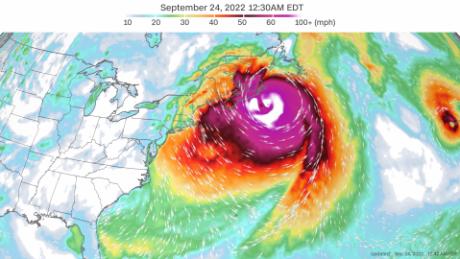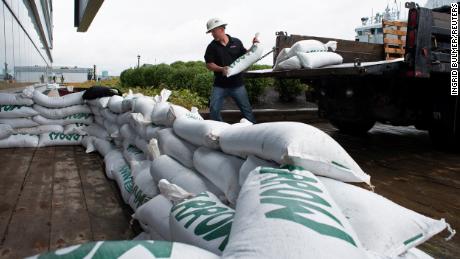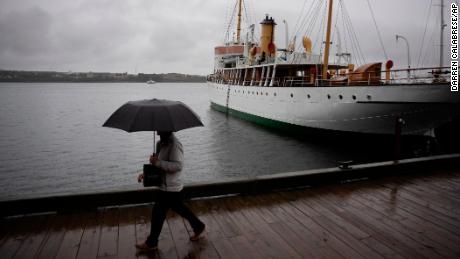Fiona makes landfall, slams Canada’s Atlantic coast with severe winds and rain
Atlantic Canada #AtlanticCanada

An unofficial barometric pressure of 931.6 mb was recorded at Hart Island, which would make Fiona the lowest pressure land-falling storm on record in Canada, according to the Canadian Hurricane Centre. Wind observations on Beaver Island in eastern Nova Scotia were recorded at 94 mph (152 km/h).
Parts of Nova Scotia and Prince Edward Island started to feel the storm’s arrival Saturday morning as winds and rains extending far from the storm’s center knocked out utilities. More than 376,000 customers across Nova Scotia have lost power so far, according to the region’s power outage center.
Residents in New Brunswick, southern Quebec, and Newfoundland and Labrador additionally face severe weather as Fiona tracks north at more than 40 mph (65 km/h) following its landfall between Canso and Guysborough in eastern Nova Scotia. Fiona is expected to pass through Cape Breton Island on Saturday morning and reach the southeastern Labrador Sea by evening.
“The storm is producing severe winds and very heavy rainfall,” the Canadian Hurricane Centre said before landfall. “Wide spread gusts of 80-110 km/h (50-68 mph) have been so far reported over Nova Scotia, Prince Edward Island and Iles-de-la-Madeleine, with a peak gust to 144km/h (90 mph) over Beaver Island, Nova Scotia.”
Fiona weakened slightly on Friday to a Category 2 storm yet is still expected to bring damaging storm surges, heavy rain and severe wind. Fiona had been a Category 4 storm early Wednesday over the Atlantic after passing the Turks and Caicos and remained so until Friday afternoon.


Winds are extending far from Fiona’s center
Officials along the Atlantic seaboard have urged those in Fiona’s path to be on high alert and prepare for the impact of the storm, which has already claimed the lives of at least five people and shut off power for millions as it battered multiple Caribbean islands this week. Homes and water infrastructure across Puerto Rico, the Dominican Republic and Turks and Caicos were heavily damaged and many residents are still trying to recover.
Fiona is on track to be an “extreme weather event” in eastern Canada, threatening with about two months’ worth of rainfall, forecasters in Canada said Friday.
“This could be a landmark event for Canada in terms of intensity of a tropical cyclone,” and it could even become Canada’s version of Superstorm Sandy, said Chris Fogarty, Canadian Hurricane Centre manager. Sandy in 2012 affected 24 states and all of the eastern seaboard, causing an estimated $78.7 billion in damage.
Fiona became post-tropical before making landfall, arriving at the same time as a trough of low pressure and cold air to the north — much like Sandy did, according to Bob Robichaud of the Canadian Hurricane Centre.
“What these things tend to do, they tend to grow in size tremendously, which is again what Fiona is doing as well,” he said Friday. “Sandy was larger than Fiona is expected to be even. But the process is essentially the same — where you have two features kind of feeding off each other to create one strong storm like we’re going to see overnight and into tomorrow.”
Hurricane-force winds can extend up to 185 miles out from Fiona’s center and tropical-storm-force winds up to 345 miles out, according to CNN Meteorologist Derek Van Dam.


Sandbags are around the doors of the Nova Scotia Power building in Halifax ahead of Fiona’s expected arrival.
Storm surge will be ‘significant,’ officials say
In the days leading up to Fiona’s expected arrival, officials ramped up services to assist those in need and implored residents to take caution.
“It has the potential to be very dangerous,” said John Lohr, the minister responsible for the Emergency Management Office for Nova Scotia, on Thursday. “Impacts are projected to be felt across the province.”
Residents should brace for damaging winds, high waves, coastal storm surge and heavy rainfall, which may lead to prolonged power outages, Lohr said. Emergency officials have encouraged people to secure outdoor items, trim trees, charge cell phones and create a 72-hour emergency kit.
Shelters for residents have been established throughout Nova Scotia, including multiple in Halifax County, according to officials.
The area has not seen a storm this intense for about 50 years, according to Fogarty.
“Please take it seriously because we are seeing meteorological numbers in our weather maps that are rarely seen here,” Fogarty said.


A pedestrian shields themselves with an umbrella while walking along the Halifax waterfront as rain falls ahead of Hurricane Fiona making landfall in Halifax, Friday, Sept. 23, 2022.
Prince Edward Island officials also implored residents to prepare for the worst as the storm looms.
Tanya Mullally, who serves as the province’s head of emergency management, said one of the most pressing concerns with Fiona is the historic storm surge it is expected to unleash.
“Storm surge is certainly going to be significant. … Flooding that we have not seen nor can we measure against,” Mullally said Thursday during an update.
Canadian Hurricane Center modeling suggests the surge “depending on the area, could be anywhere from 1.8 to 2.4 meters (6-8 feet),” said Robichaud.
The northern portion of the island stands to bear the brunt of the storm due to the direction of the winds, which will likely cause property damage and coastal flooding, Mullally said.
All provincial campgrounds, beaches and day-use parks as well as the Shubenacadie Wildlife Park were closed Friday, the Nova Scotia Emergency Management Office said.
CNN’s Derek Van Dam, Haley Brink, Aya Elamroussi, Theresa Waldrop and Christina Maxouris contributed to this report.